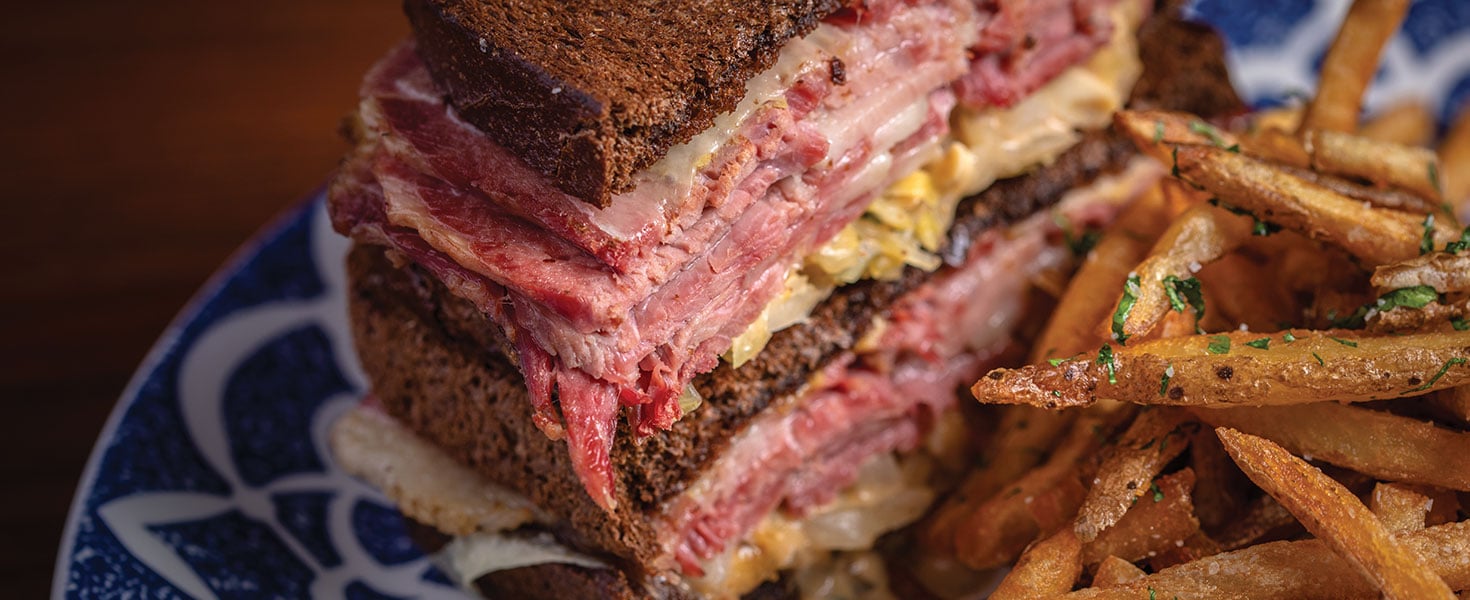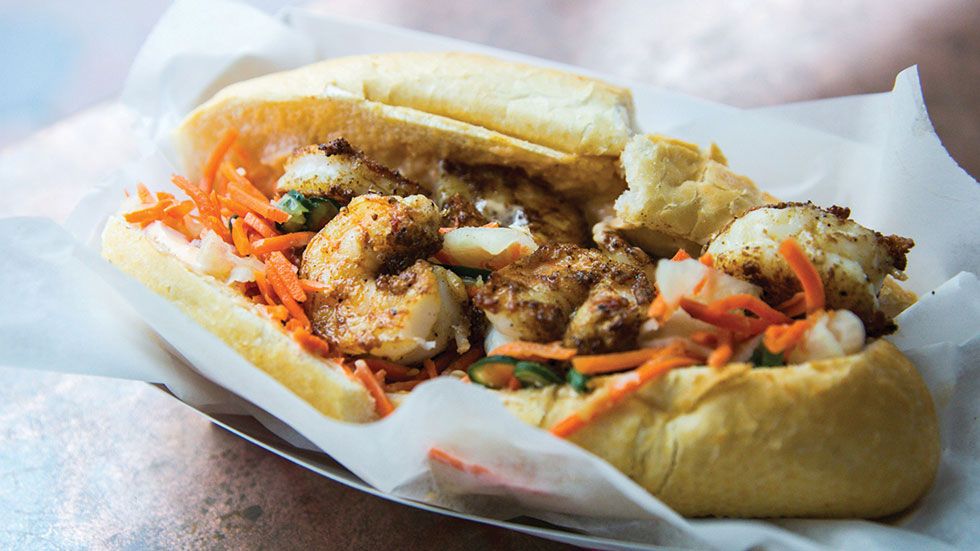Superlative Sandwiches
These iconic sandwiches elevate culinary staples into cultural treasures


Ahh, the sandwich, the greatest thing since—er, thanks to—sliced bread. Originally called “meat on bread,” the sandwich is widely believed to have been popularized in the 1760s by John Montagu, the fourth Earl of Sandwich. Legend has it that this British statesman, reluctant to interrupt a marathon card game to dine, asked the house cook to concoct something that he could eat with one hand and still gamble using the other. The ingenious cook placed some beef between two pieces of toasted bread, and—presto!—the sandwich as we know it was born.
It’d take more than a half-century for the sandwich to take hold in America; not surprisingly, our then-nascent country was inclined to jettison British customs, but the sandwich endured. Today, Americans consume an estimated 300 million sandwiches a day—yes, a day—and the sandwich is a mainstay of menus in school cafeterias and restaurants alike. If you’re as serious about sandwiches as we are (we’ve been known to justify a road trip for the simple pleasure of grilled-up goodness), may we suggest a few of our favorite regional sandwiches and the places that serve them so well?

Neighboring rivals Pat’s King of Steaks and Geno’s Steaks in South Philadelphia are the first two muststops on any taste tour of authentic Philly cheesesteaks. Photo by J. Varney for Visit Philadelphia
THE PHILLY CHEESESTEAK
You haven’t had a cheesesteak unless you’ve had a bona-fide Philly cheesesteak in Philadelphia. For it was here in South Philly where this glorious amalgam of mounds of thinly sliced, sautéed rib-eye beef smothered in melted cheese and packed inside a long, crusty roll was invented in 1930.
As the story goes, Pat Olivieri, then a hot-dog vendor, was cooking up some beef from a local butcher when a taxi driver, smelling the aroma, stopped to ask for a steak sandwich. Word spread, and soon thereafter, Olivieri debuted Pat’s King of Steaks on East Passyunk Avenue to satisfy the growing hunger for this new-fangled food.
Just across the street at rival Geno’s Steaks, however, another story prevails. The late Joey Vento, who founded Geno’s (named after his son, now the shop’s owner-operator) in 1966, claimed that he was the originator of adding cheese to create the cheesesteak. Of course, the winners in this spirited competition between these family-run businesses are always their cheesesteak-consuming customers.
Whether you prefer Pat’s or Geno’s—their neighboring locations and 24/7 business hours make it easy to try both—or any of the slew of eateries in South Philly and beyond that make a mean cheesesteak—there’s an art to ordering this culinary masterpiece.
For starters, know that the standard cheese for a cheesesteak is Cheez Whiz, with American or mild or sharp provolone acceptable alternatives. First, state the type of cheese: “Whiz,” “American” or “provolone” (or “provy”). Next, if you want fried onions on your cheesesteak, order “wit,” or for no onions, say “wit-out.” Finally, request any toppings (if they’re offered), such as ketchup, mustard, relish, sautéed mushrooms, and/or hot or sweet peppers. So, if you want a cheesesteak with Cheez Whiz and onions, for example, order “one Whiz wit.”
Just be sure to order decisively and have your payment at the ready to keep the line moving and the cheesesteaks a-coming.

However you dress it, the po-boy sandwich is among New Orleans’ most beloved cultural assets. Courtesy of New Orleans & Company
THE PO-BOY
One thing that New Orleans does as well as—or dare we say even better than—its world-renowned music is its authentic fare. And among its most famous offerings is a sandwich that’s equal parts time-honored tradition, rite of passage and downright deliciousness.
The po-boy (or po’ boy or poor boy) sandwich begins with two long pieces of flaky French bread—often baked by local Leidenheimer Baking Company or John Gendusa Bakery—and then stuffed with your choice of fried shrimp, softshell crab, oysters, roast beef, sausage or any variation you can dream up. Then, it’s “dressed” in gravy, mayonnaise or remoulade sauce and crowned with fresh lettuce, tomatoes, pickles or whatever other fixins’ your po-boy-loving heart desires.
Sounds like a rich sandwich, right? So, what gives with the name? The genesis of the po-boy can be traced back to two brothers, Bennie and Clovis Martin, former streetcar conductors who owned a coffee stand and restaurant in the French Market during the Great Depression. During a streetcar worker strike in 1929, the brothers offered to feed any struggling streetcar striker for free. They enlisted the help of a local baker, John Gendusa, to create their filling, affordable-to-make sandwich. When a striker would come to the backdoor of the shop for a free sandwich, the brothers would yell, “Here comes another poor boy!”
The po-boy is ubiquitous at restaurants, diners, corner stores and food trucks throughout the Big Easy. Popular spots include Parkway Bakery & Tavern, a beloved neighborhood landmark that’s been serving up scrumptious po-boys since 1929; Domilese’s Po-Boy and Bar, a fourth-generation family-run establishment founded in 1918 with po-boy perfection belying its humble corner-store digs; and Mohony’s Po-Boys & Seafood, known for its award-winning dressed peacemaker (considered the predecessor to the po-boy), composed of fried jumbo gulf shrimp and oysters, cheddar cheese and candied bacon.
Variations on the sandwich abound, but the best po-boy is sure to be the one you just enjoyed.

One of the secrets to the famous pastrami on rye at Katz’s Deli in New York City is a slow curing method that takes the meat to the next level of scrumptiousness. Courtesy of Visit Omaha
PASTRAMI ON RYE
Sussman Volk, a Lithuanian immigrant and owner of one of the earliest delis in New York City, is most often credited with introducing America to the pastrami on rye sandwich in 1888. Supposedly, Volk was given the recipe from a Romanian friend in exchange for storing his luggage at Volk’s shop. It didn’t take long for the sandwich to take off and become a fixture on Jewish deli menus throughout New York.
While the story of how the pastrami on rye came to be may or may not be a bit apocryphal, few can argue that it’s Katz’s Delicatessen, which also dates to 1888, that’s most famous for this signature sandwich.
Katz’s is a veritable institution in New York’s Lower East Side, which served as a meeting place for millions of new immigrant families and performers from the nearby theaters in its early days and continues to be a lively gathering spot for locals, celebrities, politicians and tourists alike today. (Movie fans may also recognize Katz’s from the “I’ll have what she’s having” scene in the 1989 rom-com When Harry Met Sally.)
Sure, much has changed in the neighborhood over the past century, but one culinary constant remains: the popularity of Katz’s pastrami sandwich. What makes Katz’s creation such a standout is the melt-in-your-mouth pastrami produced from a slow curing method that takes up to a whopping 30 days (that’s about 10 times as long as some curing methods) to bring out the flavors of the seasoned, smoked beef without the addition of chemicals or water. That and the fact that this sandwich is constructed with layer upon layer of said juicy pastrami embedded between two slices of fresh deli rye bread. Toppings may include cheese, tomato, lettuce, onion, coleslaw and sauerkraut. And while a slathering of spicy brown mustard or, sometimes, Russian dressing is apropos, Katz’s cautions: “ask for mayo at your own peril.”

Omaha Magazine’s Best of Omaha 2020. Courtesy of Visit Omaha
THE REUBEN
Of course, you can’t mention the pastrami on rye without talking about its culinary cousin: the Reuben. While many point to New York as the birthplace of the Reuben, Omaha, Nebraska, claims this celebrated sandwich as its own.
It was here at the Blackstone Hotel in the early 1900s that many say the Reuben was conceived by local grocer Reuben Kulakofsky, who often played poker at the hotel with a group of friends, nicknamed “The Committee.” One night, Kulakofsky had the idea for a hearty sandwich made of corned beef, Swiss cheese, sauerkraut and Thousand Island dressing on Russian rye bread.
Bernard Schimmel, hotel owner Charles Schimmel’s son, whipped up the sandwich, which was an instant hit with the poker group. Charles Schimmel named the sandwich after Kulakofsky and featured it on the dinner menu in 1925. The sandwich went on to earn rave reviews—and win a national recipe contest—propelling it into sandwich history.
Over the years, the Blackstone Hotel has changed hands several times, but the latest incarnation returns the historic hotel to its former glory. Opened just last year, the Kimpton Cottonwood Hotel embraces the Blackstone’s history, including prominently featuring the Reuben sandwich at its Orléans Room and Committee Chophouse restaurants in the landmark Second Renaissance Revival building where it was invented.
Piled high with prime brisket that’s brined for up to 10 days and cooked overnight and then complemented by Gruyere cheese (yes, a departure from the original, but even Reuben traditionalists may be pleased) and housemade sauerkraut and Thousand Island dressing, the Cottonwood Hotel’s Reuben has quickly become the most popular item on the lunch menu.
The Reuben is also showcased on sandwich boards at some 50 restaurants throughout the city. Noteworthy among them, the Crescent Moon pays homage to the original with a Blackstone Reuben made with slow-cooked corned beef, Swiss cheese, Thousand Island dressing and a special sauerkraut blend served on grilled marble bread. Barrett’s Barleycorn pub also dishes up an award-winning classic Reuben as well as a calorie-trimmed turkey Reuben.
Who knew that card games and the Reuben—or for that matter, the sandwich in general—shared so much history? Whether the Earl of Sandwich was an avid gambler or not—a duller story attributes his spending long hours working at his desk for the advent of the sandwich—we bet that the Earl would approve of America’s sandwich innovation as a win-win for sandwich enthusiasts everywhere from here to…well, Sandwich.
